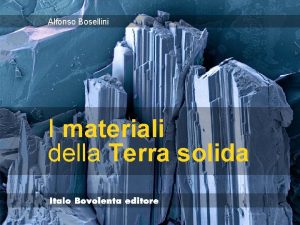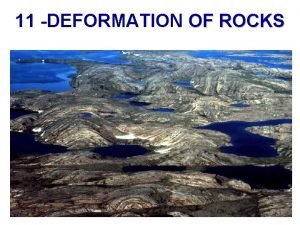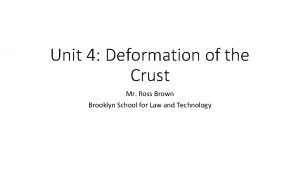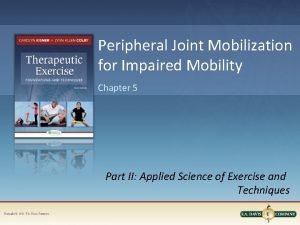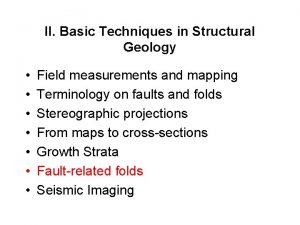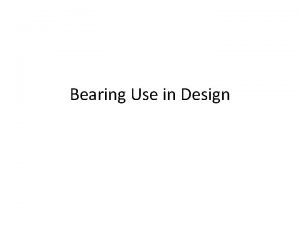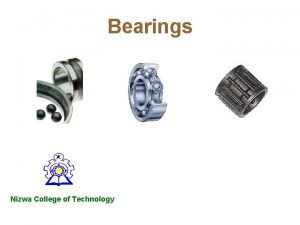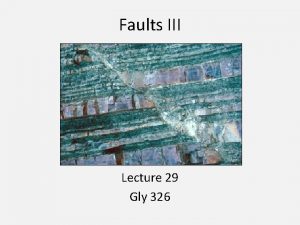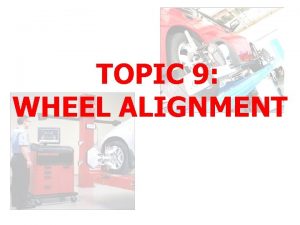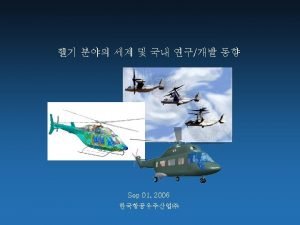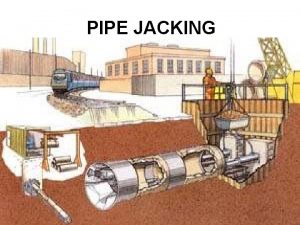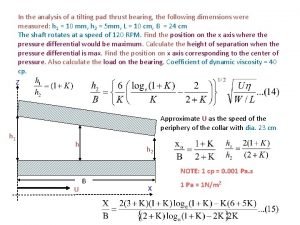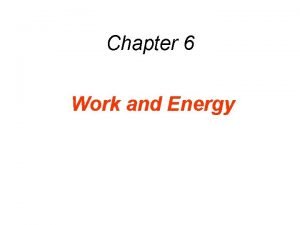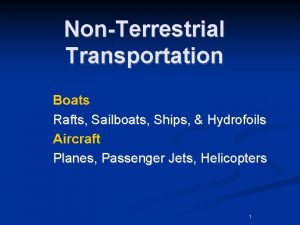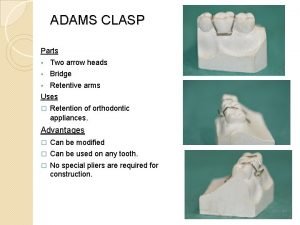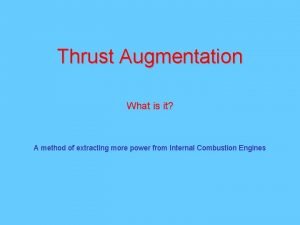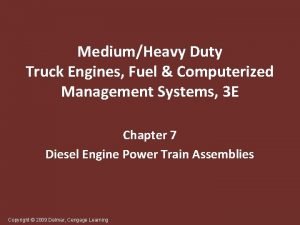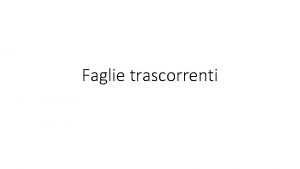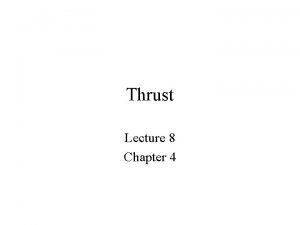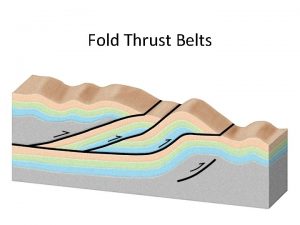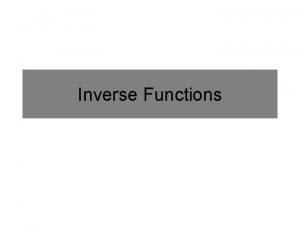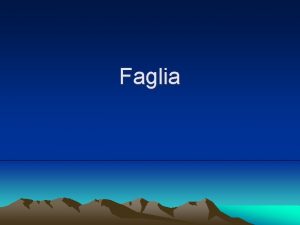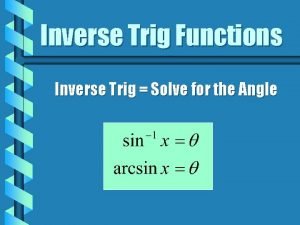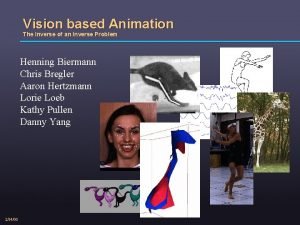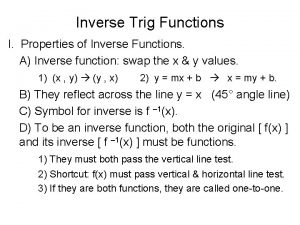FAGLIE INVERSE e THRUST FAGLIE INVERSE e THRUST






































- Slides: 38

FAGLIE INVERSE e THRUST

FAGLIE INVERSE e THRUST

Thrust Un thrust è una faglia contrazionale che accomoda un raccorciamento orizzontale di una data superficie, come la stratificazione in rocce di crosta superficiale o una foliazione regionale in rocce metamorfoiche. <generalmente, un thrust sovrappone strati più antichi su strati più giovani e quindi causa la duplicazione della successione stratigrafica. Una faglia inversa è una faglia che taglia diverse unità litologiche quindi con un’inclinazione superior a 45° mentre un thrust è meno inclinato di 45°. Uno scollamento (o Décollement o Detachment) è un thrust che forma un piccolo angolo con le unità litologiche. Thrust a basso e alto angolo possono essere segmenti diversi della stessa faglia perchè I thrust sono raramente planari. Più spesso sono listrici (con la concavità verso l’alto) o antilistrici (con la concavità verso il basso).

A causa della sua inclinazione (θ) il raccorciamento è più piccolo rispetto al displacement d di una faglia planare. La relazione è ΔL=dcosθ. a parità di displacement, una faglia a basso angolo (thrust) accomoda più raccorciamemto orizzontale rispetto ad una faglia ad alto angolo (faglia inversa) Il displacement generalmente decresce verso l’alto e un thrust può terminare prima che raggiunga la superficie Terrestre. In questo caso si chiama blind thrust (thrust cieco). I thrust che invece raggiungono la superficie si chiamano thrust emergenti. La terminazione di una faglia sulla superficie Terrestre si chiama traccia di faglia. La roccia immediatamente sopra e sotto la faglia (non verticale) sono, rispettivamente, il tetto (hanging-wall) e il letto (footwall). I sovrascorrimenti (overthrust) interessano lo spostamento (displacement) di rocce di tetto che formano thrust-sheets (o nappes). Rocce all’interno di thrust-sheets che sono traslati per grandi distanze dai loro siti di origine sono dette alloctone. Queste ricoprono rocce che non si sono mosse troppo e che sono dette autoctone. Nel caso di piccolo traslazioni le rocce sono dette para-autoctone. Thrust-sheets disaccoppiati dalle rocce sottostanti da scollamenti tendono ad essere sottili confrontati con le loro dimensioni orizzontali.

L’effetto dell’erosione: finestre e klippe Una finestra tettonica (tectonic window) si forma quando l’erosione crea uno squarcio nel thrust-sheet ed espone le rocce di letto che si trovano sotto il thrust. In mappa le rocce autoctone o para-autoctone sono completamente circondate da rocce alloctone del tetto. Un klippe è quello che resta di un thrust-sheet circondato completamente in mappa dalle rocce di letto. Klippen e finestre sono indicatori dello spostamento minimo. Avanpaese/retropaese plurale di klippe=klippen L’avampaese (foreland) è l’area di letto posta difronte il thrust, verso cui il thrust si muove. Gli avampaesi sono i margini della catena orogenica e sono regioni ribassate topograficamente in regioni montagnose attive. I sedimenti di avampaese si ispessiscono verso il fronte della catena. La regione dietro il thrust frontale è il restropaese (hinterland), che definisce la regione interna assiale di una catena orogenica. I retropaesi sono regioni rialzate topograficaamente e formano rilievi in zone montagnose attive. La propagazione dei thrust procede dal retropaese all’avampaese (thrusting in sequenza o sequenza di tipo piggy -back).

Stili deformativi dei thrust Due stili deformativi sono generalmente invocati per descrivere la tettonica a thrust, essi sono la tettonica pellicolare (thinskinned tectonics) e quella profonda (thick-skinned tectonics). Thin-skinned tectonics La thin-skinned tectonics si riferisce principalmente al thrusting che non interessa il basamento. La successione sedimentaria inizialmente sub-orizzontale è scollata lungo un orizzonte di debolezza (e. g. , sale, argille, livelli in sovrapressione) ed è deformata indipendentemente dal sottostante substrato. Tipicamente la deformazione è confinata alla copertura, mentre il basamento scivola sotto in modo rigido. Thick-skinned tectonics Nelle zone di retropaese come zone metamorfiche e cristalline (core-complex) la deformazione è principalmente controllata da thrust ad alto angolo che interessano il basamento. Questo stile è chiamato thick-skinned tectonics. Questo tipo di tettonica la si osserva anche nella placca subducente come nel caso della placca Adria al di sotto dell’Appennino meridionale.


con la stessa geologia in superficie posso ricosruire la struttura in profondità secondo due modelli. a) thin-skinned: il thrust con geometria ramp-flat interessa solo la porzione superficiale e forma una fault-bend fold (grande displacement e grande raccorciamento orizzontale). b) thick-skinned: il thrust ad alto angolo (ramp) intersessa solo il basamento e froma una faultpropagation fold (basso displacement e basso raccorciamento orizzontale)

Geometria dei thrust La traiettoria dei thrust è il percorso che la faglia disegna attraverso la stratigrafia. Dove i thrust sono coinvolti nella thinskinned tectonics essi interessano rocce stratificate orizzontalmente. Generalmente essi seguono traiettorie a scalinata verso l’alto con segmenti paralleli alla stratificazione (flat) e segmenti che tagliano gli strati (ramp). Flat Un flat è il segmento della faglia quando essa è parallela per grandi distanze ad un orizzonte stratigrafico, generalmente incompetente. I flat dove il tetto scivola lungo orizzonti di debolezza sono chiamati anche piani di scollamento. Due flat paralleli sono distinti in floor (o bottom o sole) thrust e roof (o top) thrust. Ramp Le rampe si formano quando un thrust si arrampica attraverso un successione stratigrafica competente, generalmente per brevi distanze e con angoli tra 30 e 45° rispetto alla stratificazione. Generalemnte i thrust risalgono lungo la sezione in direzione del trasporto tettonico. Le rampe frontali normalmente mostrano direzioni perpendicolari al trasporto tettonico. Nei thrust system le rocce sono spinte insieme verso le rampe frontali che perciò sono contrazionali. Le rampe possono essere anche oblique o parallele alla direzione del trasporto tettonico (lateral ramp, transfer e tear faults).






Cut-off points and lines The intersection between a particular contact (e. g. a bedding plane) and a fault plane is a cut-off line, which is a cut-off point in cross-section. For a given stratigraphic surface, there is a footwall cut-off point and a hanging-wall cut-off point. The amount of displacement on the given section is the separation between footwall and the corresponding hanging-wall points. The angle between the section and the slip direction must be known to calculate the actual displacement.




Thrust propagation Most of our understanding on thrust propagation stems from studies in fold-and-thrust belts, these areas of associated folding and thrusting usually occupying a marginal position with respect to the metamorphic axial zones of orogens. In foldand-thrust belts one may study the important processes that control shortening of the upper (essentially sedimentary) crust.

Sequence Thrusts commonly propagate and cut up-section in the direction of slip. The major, lower décollement is initiated and climbs over a first ramp to an upper flat (which can be the topographic surface), thus bringing older (or from deeper) rocks over younger (shallower) rocks. The first ramp is deactivated when the thrust movement is transferred to the front of the system over a second ramp climbing from the same décollement surface. A third and additional ramps then form successively forward as long as shortening must be absorbed. Accordingly, younger, normal sequence thrusts form one after the other from the hinterland toward the foreland. In this way, the thrust system grows at the expenses of the foreland, new ramps cutting into foreland areas while older ones are abandoned.

However, new thrusts may develop back from the frontal thrust or in a random succession within the already thrustfaulted and folded hinterland. Slip on new or reactivated thrusts behind the front of a thrust system is “out-ofsequence”. These definitions implicitly mean that a master thrust flat is permanently active during the shortening history, while most of associated thrust faults are transient structures with a short lifetime.

Imbricate fans Faults with large displacement commonly die out in a set of smaller, commonly sub-parallel splay faults. They normally form sequentially as the location of the frontal fault surface jumps ahead to ramps that cut into the foreland. Splay faults branching off and ramping all in the same direction out of the main, deeper décollement make an imbricate fan; the fan spreads the major displacement over a large volume of rock.

The junction line where the main thrust fault splits into two smaller thrust surfaces is a branch line. The branch points are where the traces of two thrusts meet on a cross-section. Attention: do not confuse with the intersection line of two non-contemporaneous fault planes, the older against the younger. The individual thrust sheets of the imbricate fan are schuppen (fish-scales in German). The branch points at the floor of an imbricate fan, where two thrusts separate toward the foreland, are called trailing branch points. The merging point of two thrusts joining into one as they are traced toward the foreland are called leading branch points.

The youngest splay is the front thrust in a leading fan. Maximum displacement is absorbed in the frontal thrust. In that case, the youngest splay carries the older one “on its back”, which is called piggy-backing. Stacking of new imbricates at the frontal base of the fan progressively steepen the older splays and horses through passive rotation to the back. The youngest splay is at the rear in a trailing fan. In that case there is thrusting over older splays. One of these reactivated splays absorbs maximum displacement.

Piggy-back transport Where the later thrust develops in the footwall of the original thrust, structurally higher and older thrusts and hanging-walls are carried forward in a piggyback manner by lower, younger thrusts. Conversely, if the thrusts migrate backwards, an overstep sequence develops. Tectonic triangles and wedges A block of rocks contained between a pair of oppositely moving, conjugate thrusts is a tectonic wedge. It is a pop up when the conjugate thrusts and back thrusts diverge upward, thus tend to move the block upward. The tectonic wedge is a triangle zone when the bounding thrusts and back thrusts diverge downward, thus tend to push down the block. A tectonic wedge is the leading edge of a thrust unit between a pair of oppositely moving but merging fault planes (imagine entering a crocodile mouth). Duplex structures Definition Thrust systems commonly involve several approximately parallel décollement-surfaces whose location and extent are controlled by weak layers at different levels of a sedimentary pile. A thrust-duplex consists of a series of sub-parallel ramps that branch off a relatively flat, lower floor thrust (also called sole thrust) and merge upward into the upper roof thrust. The whole structure encloses a package of S-shaped, detached slices of rock stacked in a systematic manner. The individual imbricate lenses are called imbricates or horses. Typically, horses make a progressively larger angles with the roof- and floor-faults from front to back (like in leading fans). Unlike an imbricate fan, a thrust duplex is contained within the sedimentary sequence.


Relationship between folds and thrusts Asymmetric, open to close, eventually overturned folds are commonly explained with thrust-propagation models, which employ migrating, kink-shaped hinges and relate fold geometry entirely to fault geometry, slip and to the thickness of the transported layers. Such models assume that faults propagate gradually and that accumulating slip, which must be zero at the front tip, is largely absorbed in contemporaneous folding. However, other models show that folding precedes thrusting and that the periodicity of thrusts is inherited from the buckling wavelength of the earlier folds.

Three geometric types of thrust-related folds are recognized: detachment folds, fault-propagation (or tip-line) folds and fault-ramp (or fault-bend) folds. Note that they represent three different (eventually successive) stages of the development of a ramp.

Fault-propagation (tip-line) folds Description Blind thrusts often terminate upward in splays from a flat décollement, forcing layers to bend ahead of the propagating fault tip as material moves up the ramp. Folding is coeval with thrust propagation. The results are markedly asymmetric fault-propagation folds whose shape depends on the amount of displacement along the basal décollement, the ramp inclination and the slip to propagation ratio. Fault-propagation folds are tighter downward.

Fault-ramp (-bend) folds Fault-ramp folds develop where a blind thrust ramps up from one flat to a higher level flat. Folding postdates the thrust development. Description Material displacement over non-planar thrust planes induces distortion of the hanging-wall. The geometric characteristics of this distortion depend on the orientation and size of the fault topography with respect to the transport direction. The trend of the resulting fault-ramp folds reflects the strike of the ramp below the thrust sheet. The forelimb of fault-ramp folds is always located on the foreland side of their associated ramps. The rear limb is parallel to and behind the ramps.

Tear faults and compartmentation Tear faults (or transfer faults) accommodate differential displacement of different parts of a segmented thrust sheet. If these faults are inclined, they form lateral ramps for the moving thrust sheets.



Thrust systems Il thrusting è il meccanismo primario per la costruzione delle montagne. La classificazione moderna degli orogeni e dei loro sistemi a thrust si college al loro contest all’interno della tettonica delle placche. Quindi sono distinti quattro tipi di orogeni che possono effettivamente rappresentare quattro stadi di cicli di convergenza. essi sono: • Orogeni da subduzione, suddivisi in cordigliere dove l’arco magmatico è postp sul continente (tipo Ande) e insulare dove l’arco è sulla litosfera oceanica (tipo Indonesia). • Orogeni da obduzione, dove la litosfera oceanica sovrascorre su quella continentale (tipo Oman) • Orogeni collisionali che coinvolgono il contatto iniziale e lo sviluppo di una zona di sutura oceanica tra due litosfere continentali (tipo siatema Appennino-Arco Calabro-Peloritano). • Orogeni intracontinentali che si formano all’interno delle placche lontano daai margini di placca (tipo Pirenei). Quando la convergenza cessaa, l’erosione e l’isostasia prevalgono e le radici sono esposte. L’intera evoluzione può durare decine di milioni di anni o anche di più.

OROGENI COLLISIONALI

Appennino meridionale: un esempio di thick- e thin-skinned tectonics


 Diaclasi e faglie
Diaclasi e faglie Specific impulse
Specific impulse Thrust of a rocket formula
Thrust of a rocket formula Folds
Folds Thrust fault
Thrust fault Traverse staging pros and cons
Traverse staging pros and cons Buy in past participle
Buy in past participle Thrust fault
Thrust fault Passive angular stretching
Passive angular stretching Site:slidetodoc.com
Site:slidetodoc.com Blind thrust fault animation
Blind thrust fault animation Pengertian panggung thrust
Pengertian panggung thrust How do thrust reversers work
How do thrust reversers work Thrust fault
Thrust fault Bearing type
Bearing type Taper roller bearing advantages and disadvantages
Taper roller bearing advantages and disadvantages Strike slip fault
Strike slip fault Specific thrust equation
Specific thrust equation Centripetal forces ap human geography
Centripetal forces ap human geography Fault
Fault Steering axis inclination
Steering axis inclination Lift drag thrust weight
Lift drag thrust weight Thrust pit
Thrust pit Newton’s law of viscosity
Newton’s law of viscosity Is thrust a conservative force
Is thrust a conservative force Lift drag thrust weight
Lift drag thrust weight Advantages of thrust stage
Advantages of thrust stage Components of adams clasp
Components of adams clasp Thrust
Thrust Momentum kounin
Momentum kounin Thrust device vector example
Thrust device vector example Head tilt chin lift jaw thrust
Head tilt chin lift jaw thrust Thrust or trestle stage
Thrust or trestle stage Thrust equation physics
Thrust equation physics Head tilt chin lift jaw thrust
Head tilt chin lift jaw thrust Lift drag thrust weight
Lift drag thrust weight Thrust augmentation
Thrust augmentation Thrust side
Thrust side Thrust fault
Thrust fault
